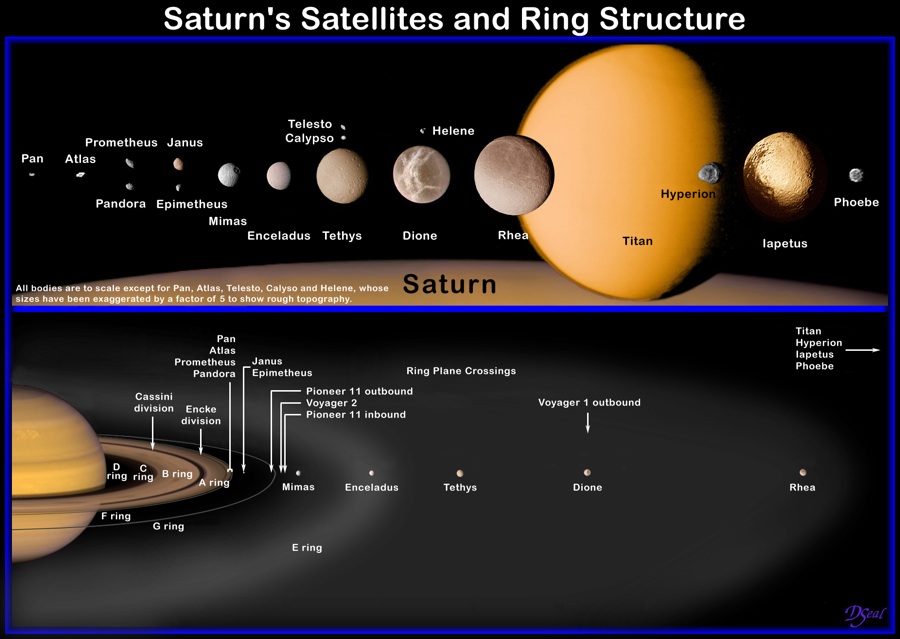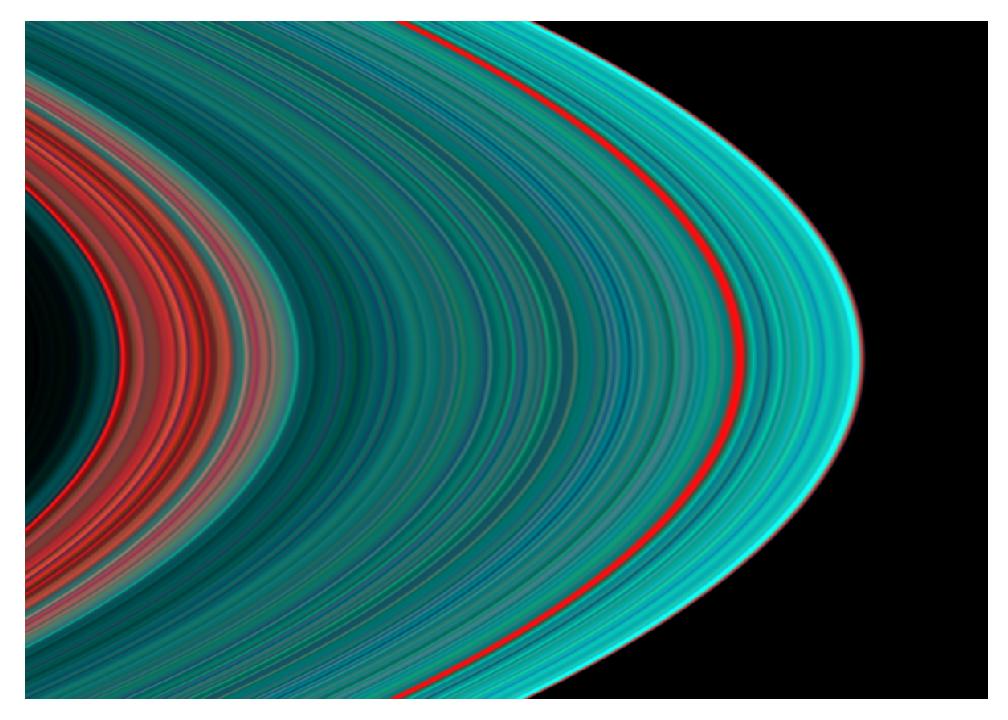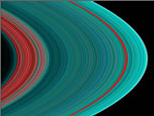
Image: Dave Seal, JPL. Shows the
relative size of some of Saturn's moons (top) and the relative
positions and spacings of the main rings and inner moons (bottom). The
"main rings" usually refers to rings A, B, C, and the Cassini Division
(which is not empty, but a distinct ring region similar to the C ring).
Information on gaps and ringlets in Saturn's rings can be found at wikipedia. More detailed information is in the book Saturn from Cassini-Huygens. The book is a collection of peer-reviewed review chapters on everything in the Saturn system except the moon Titan, which is discussed in a companion book.
UVIS Studies of Saturn's Rings. The Ultraviolet Imaging Spectrograph (UVIS) is one of twelve science instruments on the Cassini spacecraft orbiting Saturn. Larry Esposito at the University of Colorado, Boulder, is the Principal Investigator of the UVIS instrument. UVIS studies two aspects of the rings with two different telescopes: the Far Ultraviolet Spectograph (FUV) makes images of the rings in ultraviolet light, and the High Speed Photometer (HSP) observes stellar occultations. I used data from the FUV obtained when Cassini entered orbit around Saturn on July 1, 2004, to create this false color image of the rings which was featured in numerous news outlets including Time Magazine as a 2004 Picture of the Year, and (my favorite) on The Daily Show with Jon Stewart.

Information on gaps and ringlets in Saturn's rings can be found at wikipedia. More detailed information is in the book Saturn from Cassini-Huygens. The book is a collection of peer-reviewed review chapters on everything in the Saturn system except the moon Titan, which is discussed in a companion book.
UVIS Studies of Saturn's Rings. The Ultraviolet Imaging Spectrograph (UVIS) is one of twelve science instruments on the Cassini spacecraft orbiting Saturn. Larry Esposito at the University of Colorado, Boulder, is the Principal Investigator of the UVIS instrument. UVIS studies two aspects of the rings with two different telescopes: the Far Ultraviolet Spectograph (FUV) makes images of the rings in ultraviolet light, and the High Speed Photometer (HSP) observes stellar occultations. I used data from the FUV obtained when Cassini entered orbit around Saturn on July 1, 2004, to create this false color image of the rings which was featured in numerous news outlets including Time Magazine as a 2004 Picture of the Year, and (my favorite) on The Daily Show with Jon Stewart.

Image: NASA/JPL/University of Colorado.
This image was constructed from a hundreds of FUV spectra obtained of
the rings, from the outer edge of the B ring to the outer edge of the A
ring. To create the image, I summed all data taken within concentric
radial bins of the rings to improve the signal to noise ratio. I then
reprojected the data into the ring shape shown above. Mapping different
regions of the FUV spectrum to red, green, and blue, produced the image
above. The color red was mapped to emission from atomic Hydrogen gas
(which fills interplanetary space). Red regions indicate gaps and more
transparent regions of the rings. Brighter blue regions are more
reflective in the FUV part of spectrum. Because water ice is the
dominant spectrally active constituent of the ring particles, these
regions have more pure water ice and fewer non-ice contaminants.
We are studying the FUV data to identify variations in water ice abundance and grain size properties across the rings. Differences between different ring regions will constrain models of ring origin and evolution.
The UVIS HSP stellar occultation data provides the highest resolution measurements of the structure of the rings. By measuring the brightness of a star up to 1000 times per second as the rings pass in front of the star, the HSP measures ring structure at scales approaching the size of the largest ring particles (a few meters).
We are studying the FUV data to identify variations in water ice abundance and grain size properties across the rings. Differences between different ring regions will constrain models of ring origin and evolution.
The UVIS HSP stellar occultation data provides the highest resolution measurements of the structure of the rings. By measuring the brightness of a star up to 1000 times per second as the rings pass in front of the star, the HSP measures ring structure at scales approaching the size of the largest ring particles (a few meters).
 Back
to Josh Colwell's home page.
Back
to Josh Colwell's home page.